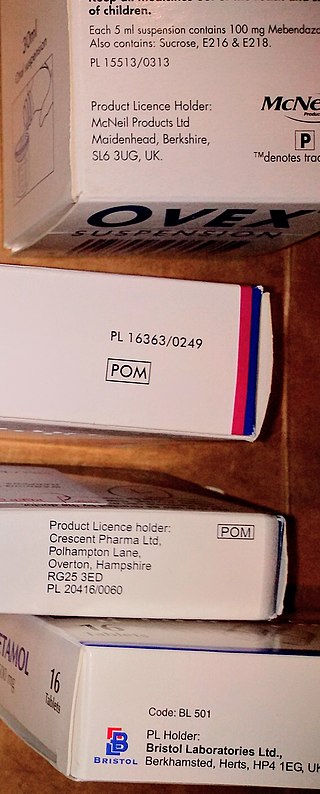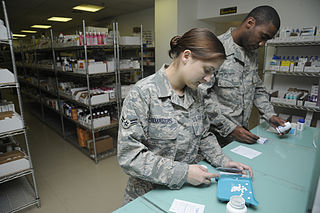Related Research Articles

Medicare is an unofficial designation used to refer to the publicly funded single-payer healthcare system of Canada. Canada's health care system consists of 13 provincial and territorial health insurance plans, which provide universal healthcare coverage to Canadian citizens, permanent residents, and depending on the province or territory, certain temporary residents. The systems are individually administered on a provincial or territorial basis, within guidelines set by the federal government. The formal terminology for the insurance system is provided by the Canada Health Act and the health insurance legislation of the individual provinces and territories.
Shoppers Drug Mart Inc., commonly known as Shoppers is a Canadian retail pharmacy chain based in Toronto, Ontario. It has more than 1,300 stores in ten provinces and two territories.

Pharmacy is the science and practice of discovering, producing, preparing, dispensing, reviewing and monitoring medications, aiming to ensure the safe, effective, and affordable use of medicines. It is a miscellaneous science as it links health sciences with pharmaceutical sciences and natural sciences. The professional practice is becoming more clinically oriented as most of the drugs are now manufactured by pharmaceutical industries. Based on the setting, pharmacy practice is either classified as community or institutional pharmacy. Providing direct patient care in the community of institutional pharmacies is considered clinical pharmacy.
Prescription drug list prices in the United States continually are among the highest in the world. The high cost of prescription drugs became a major topic of discussion in the 21st century, leading up to the American health care reform debate of 2009, and received renewed attention in 2015. One major reason for high prescription drug prices in the United States relative to other countries is the inability of government-granted monopolies in the American health care sector to use their bargaining power to negotiate lower prices, and the American payer ends up subsidizing the world's R&D spending on drugs.

A prescription drug is a pharmaceutical drug that is permitted to be dispensed only to those with a medical prescription. In contrast, over-the-counter drugs can be obtained without a prescription. The reason for this difference in substance control is the potential scope of misuse, from drug abuse to practicing medicine without a license and without sufficient education. Different jurisdictions have different definitions of what constitutes a prescription drug.
The Pharmaceutical Benefits Scheme (PBS) is a program of the Australian Government that subsidises prescription medication for Australian citizens and permanent residents, as well as international visitors covered by a reciprocal health care agreement. The PBS is separate to the Medicare Benefits Schedule, a list of health care services that can be claimed under Medicare, Australia's universal health care insurance scheme.

A comparison of the healthcare systems in Canada and the United States is often made by government, public health and public policy analysts. The two countries had similar healthcare systems before Canada changed its system in the 1960s and 1970s. The United States spends much more money on healthcare than Canada, on both a per-capita basis and as a percentage of GDP. In 2006, per-capita spending for health care in Canada was US$3,678; in the U.S., US$6,714. The U.S. spent 15.3% of GDP on healthcare in that year; Canada spent 10.0%. In 2006, 70% of healthcare spending in Canada was financed by government, versus 46% in the United States. Total government spending per capita in the U.S. on healthcare was 23% higher than Canadian government spending. U.S. government expenditure on healthcare was just under 83% of total Canadian spending.

Healthcare in Canada is delivered through the provincial and territorial systems of publicly funded health care, informally called Medicare. It is guided by the provisions of the Canada Health Act of 1984, and is universal. The 2002 Royal Commission, known as the Romanow Report, revealed that Canadians consider universal access to publicly funded health services as a "fundamental value that ensures national health care insurance for everyone wherever they live in the country."

A pharmacy technician performs pharmacy-related functions. Training, certification, licensing, and actual practice of pharmacy technicians varies not only worldwide but in some countries regionally as well as by employer.

Medicare Part D, also called the Medicare prescription drug benefit, is an optional United States federal-government program to help Medicare beneficiaries pay for self-administered prescription drugs. Part D was enacted as part of the Medicare Modernization Act of 2003 and went into effect on January 1, 2006. Under the program, drug benefits are provided by private insurance plans that receive premiums from both enrollees and the government. Part D plans typically pay most of the cost for prescriptions filled by their enrollees. However, plans are later reimbursed for much of this cost through rebates paid by manufacturers and pharmacies.
An online pharmacy, internet pharmacy, or mail-order pharmacy is a pharmacy that operates over the Internet and sends orders to customers through mail, shipping companies, or online pharmacy web portal.

A pharmacy is a retail shop which provides pharmaceutical drugs, among other products. At the pharmacy, a pharmacist oversees the fulfillment of medical prescriptions and is available to counsel patients about prescription and over-the-counter drugs or about health problems and wellness issues. A typical pharmacy would be in the commercial area of a community.

Dana Paul Goldman is the dean of the USC Price School of Public Policy, Leonard D. Schaeffer Chair and director of the University of Southern California Leonard D. Schaeffer Center for Health Policy and Economics, and Professor of Public Policy, Pharmacy, and Economics at the Price School and USC School of Pharmacy. He is also an adjunct professor of health services and radiology at UCLA, and a managing director and founding partner, along with Darius Lakdawalla and Tomas J. Philipson, at Precision Heath Economics, a health care consulting firm. Previously held positions include the director of the Bing Center for Health Economics, RAND Royal Center for Health Policy Simulation, and UCLA/RAND Health Services Research Postdoctoral Training Program.
Medication costs, also known as drug costs are a common health care cost for many people and health care systems. Prescription costs are the costs to the end consumer. Medication costs are influenced by multiple factors such as patents, stakeholder influence, and marketing expenses. A number of countries including Canada, parts of Europe, and Brazil use external reference pricing as a means to compare drug prices and to determine a base price for a particular medication. Other countries use pharmacoeconomics, which looks at the cost/benefit of a product in terms of quality of life, alternative treatments, and cost reduction or avoidance in other parts of the health care system. Structures like the UK's National Institute for Health and Clinical Excellence and to a lesser extent Canada's Common Drug Review evaluate products in this way.
A formulary is a list of pharmaceutical drugs, often decided upon by a group of people, for various reasons such as insurance coverage or use at a medical facility. Traditionally, a formulary contained a collection of formulas for the compounding and testing of medication. Today, the main function of a prescription formulary is to specify particular medications that are approved to be prescribed at a particular hospital, in a particular health system, or under a particular health insurance policy. The development of prescription formularies is based on evaluations of efficacy, safety, and cost-effectiveness of drugs.
Electronic prescription is the computer-based electronic generation, transmission, and filling of a medical prescription, taking the place of paper and faxed prescriptions. E-prescribing allows a physician, physician assistant, pharmacist, or nurse practitioner to use digital prescription software to electronically transmit a new prescription or renewal authorization to a community or mail-order pharmacy. It outlines the ability to send error-free, accurate, and understandable prescriptions electronically from the healthcare provider to the pharmacy. E-prescribing is meant to reduce the risks associated with traditional prescription script writing. It is also one of the major reasons for the push for electronic medical records. By sharing medical prescription information, e-prescribing seeks to connect the patient's team of healthcare providers to facilitate knowledgeable decision making.

The Canadian Snowbird Association is a national, not-for-profit organization dedicated to defending and improving the rights and privileges of travelling Canadians.

Telepharmacy is the delivery of pharmaceutical care via telecommunications to patients in locations where they may not have direct contact with a pharmacist. It is an instance of the wider phenomenon of telemedicine, as implemented in the field of pharmacy. Telepharmacy services include drug therapy monitoring, patient counseling, prior authorization and refill authorization for prescription drugs, and monitoring of formulary compliance with the aid of teleconferencing or videoconferencing. Remote dispensing of medications by automated packaging and labeling systems can also be thought of as an instance of telepharmacy. Telepharmacy services can be delivered at retail pharmacy sites or through hospitals, nursing homes, or other medical care facilities.

Doug Eyolfson is a Canadian physician and was a Member of Parliament in the House of Commons of Canada for the riding of Charleswood—St. James—Assiniboia—Headingley. He was elected in the 2015 federal election and was defeated in the 2019 Canadian federal election. He was a member of the Standing Committee on Health, the Standing Committee on Veteran Affairs and the Subcommittee on Sports-Related Concussions in Canada. He was also the chair of the Manitoba Liberal Caucus.
In January 2018, the provincial government of British Columbia (BC) began providing individuals at high risk of HIV infection with pre-exposure prophylaxis (PrEP) and post-exposure prophylaxis (PEP) at no cost. High risk individuals include men and trans women who have sex with men, people who inject drugs, and people who have sex with people living with HIV. One year following this policy change, which is delivered as part of the British Columbia Centre for Excellence in HIV/AIDS (BC-CfE)'s Drug Treatment Program, almost 3,300 people have been prescribed with PrEP or PEP.
References
- ↑ Pharmacare. Canadian Pharmacists Association. Retrieved 8 November 2020. Archived 10 November 2020 at the Wayback Machine
- ↑ Steve Paikin (5 January 2018). Is 'OHIP+' really the best option for free prescription drug coverage in Ontario?. TVO.
- ↑ General Pharmacare Questions. Manitoba Health, Seniors and Active Living. Retrieved 8 November 2020. Archived 10 November 2020 at the Wayback Machine
- ↑ PharmaCare for BC Residents. British Columbia Health. Retrieved 8 November 2020. Archived 10 November 2020 at the Wayback Machine
- ↑ Canada needs universal pharmacare (19 October 2019). The Lancet 394(10207), 1388.
- ↑ National Pharmacare Program. Canadian Society of Hospital Pharmacists. Retrieved 8 November 2020. Archived 10 November 2020 at the Wayback Machine
- ↑ Kyle Duggan (9 March 2018). A rough guide to Canada's looming pharmacare debate. iPolitics. Archived 10 November 2020 at the Wayback Machine
- ↑ Throne Speech's promise of pharmacare rings hollow (4 October 2020). NOW Magazine. Archived 10 November 2020 at the Wayback Machine
- ↑ Hannah Thibedeau (19 October 2019). Liberals aren't setting aside enough cash yet for pharmacare, says advisory panel chair. CBC. Archived 10 November 2020 at the Wayback Machine
- 1 2 Aaron Wherry (23 February 2024). Liberals and New Democrats reach a deal on pharmacare. CBC News.